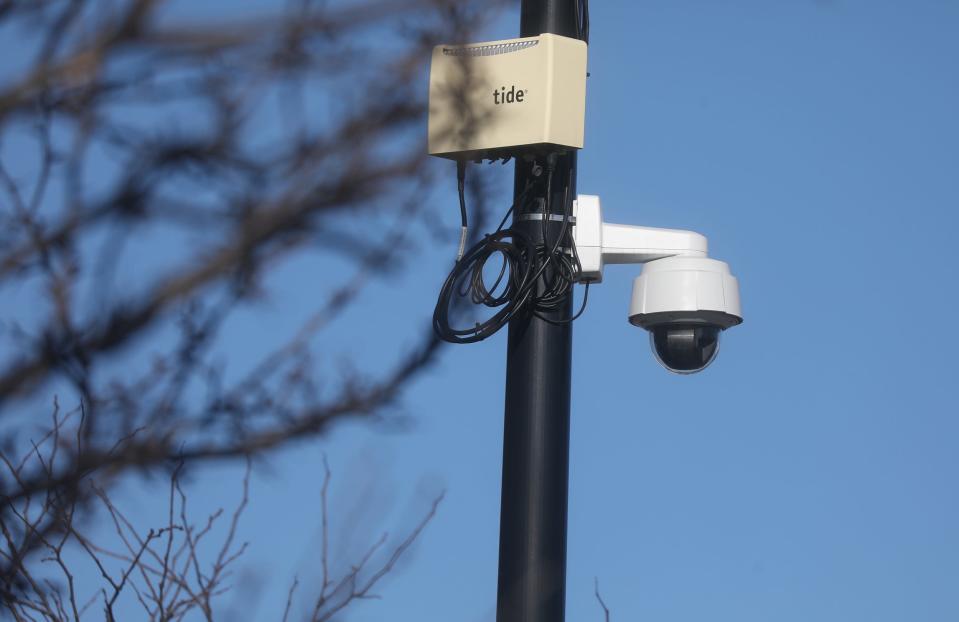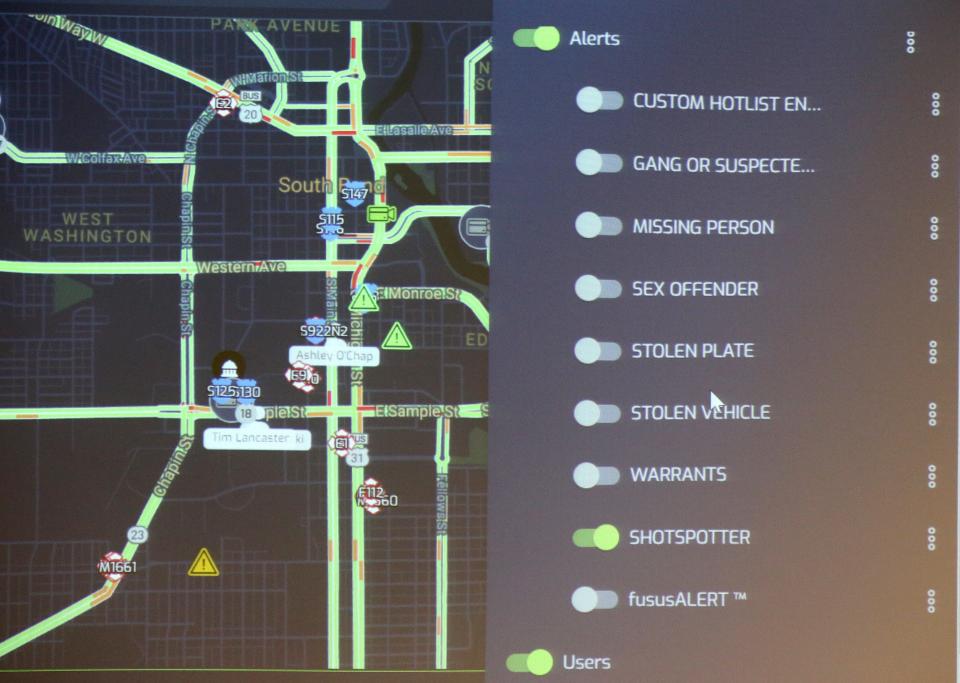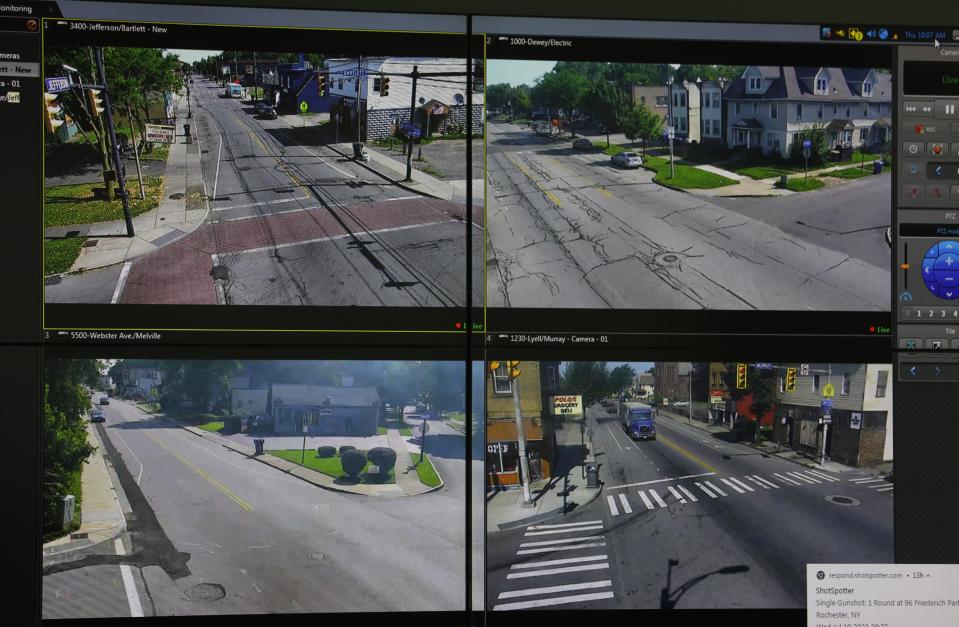Monroe County Sheriff's Office wants to tap into video feed at your school, corner store
Police officials in Monroe County are building a network of surveillance cameras that could grant them access to live video feeds inside schools, local businesses and some neighborhoods. The Monroe County Sheriff’s Office has partnered with the camera integration platform Fusus for an initiative they’re calling "Connect Monroe County."
They said that it will enhance public safety, but community discussions about privacy ramifications have been lacking.
The software will pull real-time footage from thousands of different private camera systems across the county and store it in a cloud-based server that law enforcement officers can access on their cellphones and laptops. The Democrat and Chronicle is examining police surveillance efforts in western New York as part of a new investigative project called "Eyes on Us."
If schools and corner stores soon sign onto the Fusus network, that means police could have eyes on your child while on the playground at recess or watch you walk down the street to buy milk.

The sheriff's office said they don't plan to monitor everyday civilian activity. They said they will only access the video feeds when responding to 911 calls, investigating a crime, or in place of "special attention" details, where police already heighten patrols of shopping centers and public streets following suspicious activity.
"This gives us more resources to provide a faster, more focused, safer response to crisis and emergency services," said Sgt. Greg Wildman.
At least one local college and fire department have already started testing their security cameras with the program, he said.
Fusus raises privacy concerns across country
Privacy watchdogs have been raising concerns about Fusus for years, saying it dramatically increases police surveillance power and that there are still questions about how use of the software is regulated.
“One might hope that in the face of a completely new type of surveillance system we might have laws and policies in place, but we don’t,” said Andrew Guthrie Ferguson, a law professor at American University who studies big data policing.

“Can they use it to watch First Amendment protected activities? Can they watch abortion clinics? Substance abuse clinics? Journalists who ask nosy questions about policing? Without laws, it means police can watch everything or anything in a rather generalized and arbitrary way.”
Right now, schools and businesses can choose whether to share their video feeds with police. Wildman stressed that signing up for the program is voluntary in Monroe County.
But a year after the Rialto Police Department in California launched a similar partnership, officials there made it mandatory for new or remodeled commercial and industrial buildings to register with the network and hand their live video feeds to police — stoking fears of mission creep in privacy and technology experts.
More than 100 police agencies and cities across the nation have partnered with Fusus, according to a new database by 404 Media.
The Monroe County Sheriff’s Office is the only New York police agency on that list — though researchers said the data may not be complete. However, the program will live inside Monroe County's new Regional Investigative Operations Center, meaning multiple local police agencies will eventually gain access to the network.
Wildman said while they get the program off the ground, only MCSO supervisors and RIOC analysts have direct access to the real-time footage. He said they will share the data with other local police departments as needed, and plan to train and extend access to MCSO deputies in the spring. The next phase will include other local police departments.
Wildman said the program did not require approval from the Monroe County Legislature and the software will cost the agency $125,000 per year.
MCSO signed a three-year contract with Fusus.
Read Deeper: See all the police surveillance tools used in your city
What is Fusus and how does it work?
The Fusus program has two levels: Registration and integration.
Residents can register their home security cameras on a Monroe County Sheriff’s Office database.
Registering your camera will not give police access to your live video stream, but Wildman said it helps them know where security cameras are located when they are investigating a crime. Investigators can then contact the registered resident and request access to look at footage from a specific time frame.
More: Ring bars police from seeking user doorbell footage; minimal impact here, police say
A second tier called integration allows schools and businesses to grant MCSO direct access to their camera feeds.
Integration requires the camera owner to purchase a fususCORE device that plugs into their security system and transmits the footage back to MCSO. This device can cost between $300 to several thousands, with yearly subscription fees, depending on how many cameras it will service.
MCSO says the camera owners can choose when and how police can access their real-time video feeds. In one example on the Connect Monroe County website, a business can choose to only activate the live stream when they press a “panic button” on a smartphone app, indicating there is an emergency happening.
“It is not the intention or expectation that Partner’s cameras will be routinely monitored in real-time by Agency,” reads a terms and conditions agreement on the website.
A second user agreement shared with the Democrat and Chronicle listed the following reasons police might access the video feed:
Following a 911 call involving law enforcement, fire service or emergency medical services;
To train authorized users of Fusus;
In demonstrations showing the capabilities, purpose and mission of RIOC;
To conduct surveillance in ongoing criminal investigations or in preparation of public safety events;
To conduct "special attention" details of retail, public and commercial areas.
Wildman said users can request an audit to see how often and why police accessed their footage through Fusus.
Can real-time crime centers balance privacy and public safety?
Fusus sells itself as a way to build an ecosystem of public safety.
It has built-in artificial intelligence that can rapidly search and analyze video for things like weapons, cars and backpacks. The company said it does not use facial recognition technology, but the system can interface with other controversial surveillance platforms like license plate readers and predictive policing software.
Wildman said the technology will help first responders approach emergencies with more information.
“Let’s say, worst case scenario, you have an active shooter at a school,” he said. “We can pull up that school’s cameras right away before the cops are even there and start looking for things … Where did the bad guy park his car? How many bad guys are there?”

Fire departments and EMS could also use the technology to canvass public streets during severe weather events, like the deadly Buffalo blizzard in 2022, Wildman said.
He described special attention details as routine police work, where an officer or deputy might temporarily ramp up patrols of a certain area following a homicide or when looking for a missing child from that neighborhood. Police will occasionally check the camera feeds for the same reason, he said, but don't plan to keep watch like a 24/7 security system.
"Without that cause, then we're not going to (check the cameras)," Wildman said.
What do privacy advocates say about Fusus?
Privacy advocates said such examples prey on the community’s fear, using horrific hypotheticals to justify increased surveillance, when the technology will more likely be used to prosecute petty crimes like shoplifting.
“Is the potential benefit in the case of an emergency situation worth the cost of 24/7 surveillance?” said Ferguson, the law professor. “99.9% of the footage will be of innocent people living their lives under increased government surveillance.”
And they worry it could influence how different communities are policed.
Dave Maass, director of investigations at the Electronic Frontier Foundation, said if only high-end retailers hand over their cameras, police might end up spending more resources tracking down thefts of Rolex watches than anything else. Or, he said, a network of surveillance cameras in certain neighborhoods could lead to increased monitoring of people living in poverty or communities of color.
Daniel Schwarz, a senior privacy and technology analyst with the NYCLU, said after reviewing the Connect Monroe County website, he believes the community needs more information about how their video footage would be stored or used — including if Fusus has access to shared footage for its own needs.
The small start-up was recently acquired by the police technology giant Axon, priming Fusus to expand its reach and surveillance capabilities.
Wildman said more information will be available on the Connect Monroe County website soon.
What's next for Fusus in Monroe County?
The Democrat and Chronicle has asked for contracts, training documents and internal policies that govern what Fusus will look like in Monroe County. Some of those materials are still being developed, Wildman said.
While the initiative is still in its early stages, Wildman said MCSO will be building its Fusus network “very, very aggressively.”
Since it launched last month, there are 63 cameras registered and 142 cameras integrated into the program.
The Atlanta Police Department, which has one of the largest Fusus networks according to the 404 Media database, has access to over 18,000 integrated cameras. And that number is growing daily.
— The Democrat and Chronicle is examining police surveillance efforts in western New York as part of a new investigative project called "Eyes on Us." Do you have questions about Fusus or police surveillance? Email us at kcanne@gannett.com and we might answer them in an upcoming series of stories.
— Kayla Canne reports on community justice and safety efforts for the Democrat and Chronicle. Get in touch at kcanne@gannett.com or on Twitter @kaylacanne.
This article originally appeared on Rochester Democrat and Chronicle: Police surveillance in Monroe County heightened with new Fusus tool

